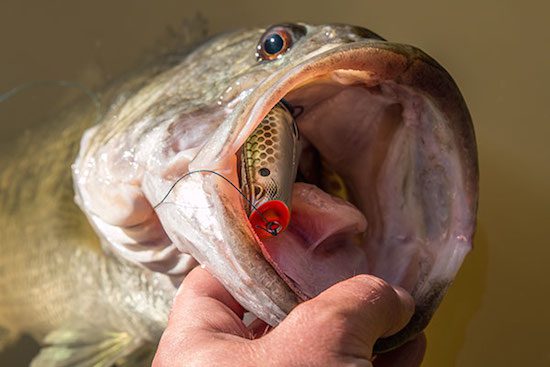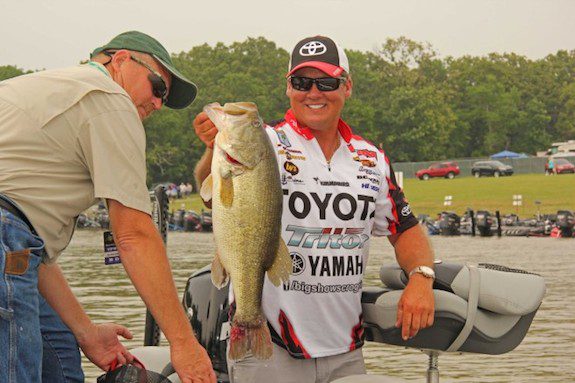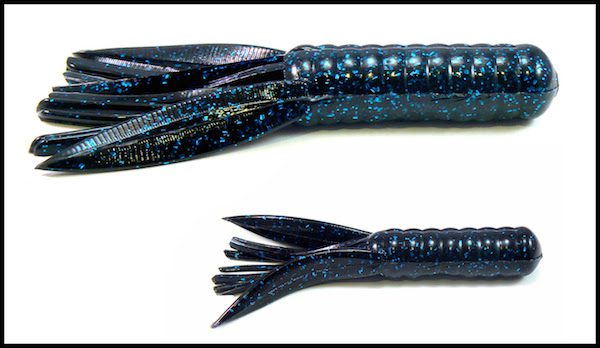
Lake Gaston – Eaton’s Ferry marina
4/19/2014
Final Results
 1st Place Don Warren & Robert Whitus
1st Place Don Warren & Robert Whitus
 2nd Place Howard Midkiff & Dwight Dixon
2nd Place Howard Midkiff & Dwight Dixon
Click Here To See Full Results
Warren and Whitus set personal best on Lake Gaston
Richmond Marine Center’s AC Tournament Trail Virginia Division second event of the year took place on Saturday April 19th on Lake Gaston. We had 22 teams in the event today launching from Eaton Ferry Marina. Once again the weather forecast was not looking good. We were expecting a 70% chance of rain with NE winds at 10-15 mph. However, unlike our season opener, the weatherman was a little off on this one. We really dodged a bullet with rain only causing you to wear your rain suite all day just to keep warm. With morning temps in the low 40’s and afternoon highs in the mid to upper 50’s, the moisture in the air and the NE wind made it feel a lot colder. Regardless of the unfavorable conditions, the fishing was excellent.
Don Warren and Robert Whitus broke the code today and topped the field of anglers with 5 bass weighing an outstanding 24.52 lbs. The winning team also captured the Big Bass award for the tournament with a Virginia beauty weighing 8.20 lbs. This was a personal best for Warren as he was finally able to break the 20lb barrier in a tournament in the process. Warren and Whitus concentrated on pre-spawn fish with jigs, texas rigged creature baits and a Yum Flash Mob Jr. The team was fishing main lake stumps and rocks with current breaks from the recent rains and capitalized on the aggressive activity the conditions provided. The tournaments Big Bass was caught on a ½ oz green pumpkin jig and trailer. With the first place prize and big fish the team took home $1,336 in winnings.
Second Place honors went to the team of Howard Midkiff and Dwight Dixon with 5 bass for a total weight of 18.28 lbs. The team concentrated fishing shallow diving crankbaits in stained water for spawning and pre spawn bass. They took advantage of the cloud cover and wind to cover water for their catch. This team proved you do not need a high dollar fiberglass rig to compete on this level. They fished from their aluminum jet drive that they use on the upper James River to find their creel. They also had the events 2nd big fish weighing in at 5.90 lbs. The team took home $688 for their efforts.
Finishing third from their Richmond Marine Center Legend Alpha 199 was David Allen and Clayton Mullins with 5 bass tipping the scales at 17.54 lbs. Team Allen and Mullins started the morning site fishing for fish they had found in practice. The conditions would not allow them to actually see the bass, but rather make repeated cast to the beds they knew were there from practice. The team was able to finish their limit and upgrade throughout the day fishing and All Terrain Jig in the Moyna Magic color and a Livingston Lures Dive Master Jr. in Chartreuse Sunrise Shad on rip rap around bridges. Allen and Mullins took home $421 for their 3rd place finish. They were also the winners of the AC Tournaments Decal Contingency Award and will receive an additional $100 from AC tournaments.
The Virginia Division also offers the Missile Baits “Boost Award” to the team that finishes the first spot out of the money in each event. The Missile Bait “Boost Award” winning team for Lake Gaston event was the team of Keith Joyce and Doug Washburn with a total weight of 16.02 lbs. The team will receive $50.00 in Missile Baits products of their choice. Congratulations!
For the event, we had a total of 92 fish brought to the scales for a total weight of 268.16 lbs for an average of 2.91 lbs per fish. With the water temperature ranging from 52-64 degrees, the lake is producing fish in all phases of the spawn.
Richmond Marine Center’s AC Tournament Trail Virginia Division could not exist without great sponsors. We would like to thank Richmond Marine Center for logistics and organizing the set up and take down for the event. If you are looking for a new bass boat or need service on your current rig, give Ben Gibson a call, they will take great care of you and your equipment.
A big thank you goes out to Hopkins Gun and Tackle located in Mechanicsville, VA for the awesome weigh-in trailer that provided us protection during the terrible weather conditions. If you have not visited their store, make plans to do so soon. They carry everything a bass fisherman could want and need for their tournament success.
We would like to thank these other great sponsors, Missile Baits, ALX Rods, Optima Batteries, Jethro Baits, Lowrance Electronics, All Terrain Tackle, Propeller Dynamics and Sqwincher.
AC Tournament Trail National Sponsors: Legend Boats, Mercury Outboards, Motorguide, Rayjus, SolarBat, TFO Rods, Lunker Lure, Fishidy, SureLife, EGO S2 Slider and Bass Tackle Depot.
Our next event will be on The Chick River at Route 5 Riverfront Park. If you have questions about the upcoming events or the tournament trail, please feel free to give me a call. Jeff Salmon 804-221-7653



 Available now on
Available now on 



















